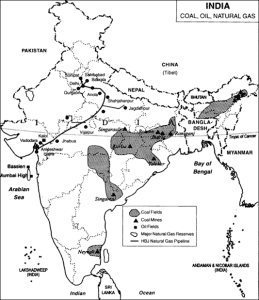TAG: GS 3: ECOLOGY AND ENVIRONMENT
THE CONTEXT: The environmental implications of transitioning from traditional rat-hole mining to open-cast mining of coal in Meghalaya.
EXPLANATION:
- The shift is prompted by the National Green Tribunal’s ban on rat-hole mining in 2014, leading the authorities to consider open-cast progressive scientific mining as an alternative.
- Despite the pending environmental clearance, four applicants have received approval for scientific coal mining, with the final hurdle being the Environment Impact Assessment (EIA)
Comparison of Mining Methods (Traditional Rat-Hole Mining vs. Open-Cast Mining):
- Impact on Vegetation and Forest Cover:
- Experts acknowledge that open-cast mining is expected to have a more significant impact on vegetation and forest cover compared to traditional rat-hole mining.
- Central Mine Planning & Design Institute Limited (CMPDIL) officials suggest that rat-hole mining minimizes subsidence of land as workers maintain underground pillars to prevent soil collapse.
- Subsidence of Land:
- CMPDIL officials endorse the view that subsidence of land is minimal in rat-hole mining due to the maintenance of underground pillars.
- This is contrasted with concerns about increased subsidence in open-cast mining.
Steps Toward Scientific Mining:
- Clearance Process:
- The Centre has given clearance to four applicants for scientific mining, and the final step is obtaining environmental clearance, which is expected to take 4-5 months.
- The SEAC will issue terms of reference for the preparation of Environment Impact Assessment (EIA) and Environment Management Plan (EMP).
- Reports Preparation:
- The four project proponents will engage NABARD-empanelled consultants to prepare EIA and EMP reports based on the SEAC’s terms of reference.
- Public Hearings:
- After the reports are ready, the Meghalaya State Pollution Control Board will conduct public hearings where both reports will be circulated in local languages.
- Clearance and Operation:
- If everything proceeds smoothly, the SEAC is expected to grant clearance in four to five months.
- Subsequently, the Meghalaya State Pollution Control Board will grant Consent to Establish (CTE) and Consent to Operate (CTO) to the four proponents.
Different types of Coal in India:
- They are peat, lignite, bituminous coal and anthracite. Peat is a precursor to coal. Another name of Lignite coal is brown coal. Bituminous coal has high heating (Btu) value. Anthracite is also called hard coal.
- Peat is a precursor to coal. It is a soft organic material and contains partly decayed plant and deposited mineral matter. On application of peat, it becomes coal.
- Lignite coal is also called brown coal. It has the least concentration of carbon. It is the lowest grade coal.
- Bituminous coal has high heating value. It is used in the generation of electricity. It appears smooth and shiny. However, it has layers.
- Anthracite is hard and brittle. It has black lustre. It is also called hard coal. It has a high percentage of fixed carbon and low percentage of volatile matter.

Conclusion:
- The transition from traditional rat-hole mining to open-cast scientific mining in Meghalaya involves a complex process of obtaining environmental clearances.
- The discussion reflects a balance between environmental concerns, economic benefits, and regulatory procedures in shaping the future of coal mining in the region.
- The decision-makers, while recognizing the environmental impact, are driven by legal mandates and economic considerations in paving the way for scientific mining.
SOURCE: https://theshillongtimes.com/2024/02/15/open-cast-mining-may-harm-the-environment-experts/
Spread the Word
